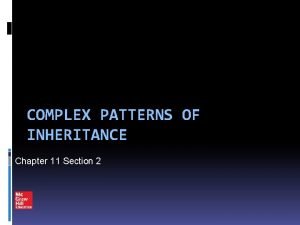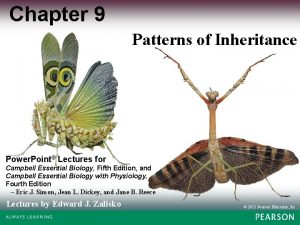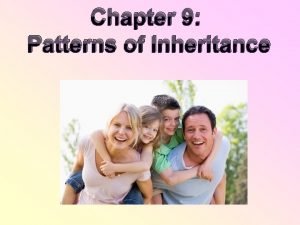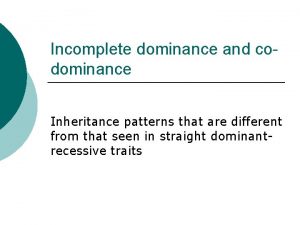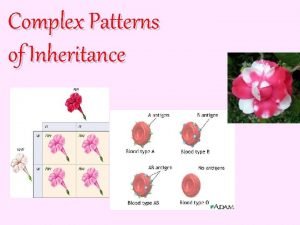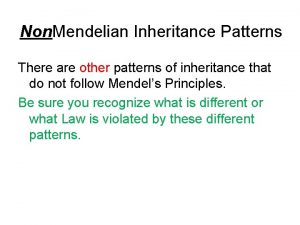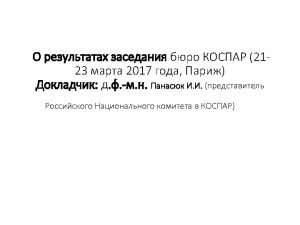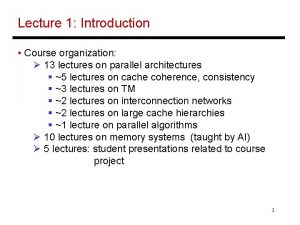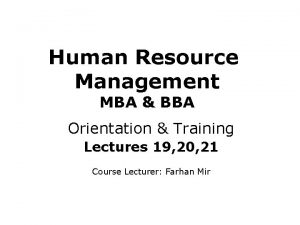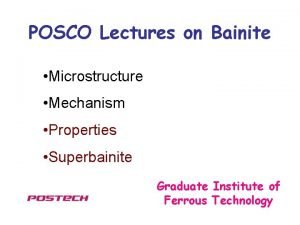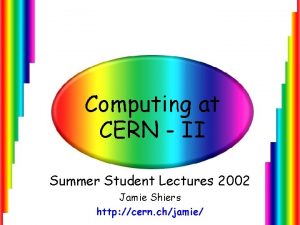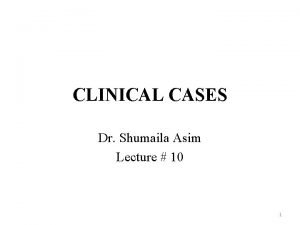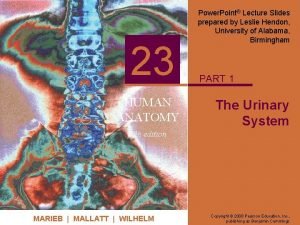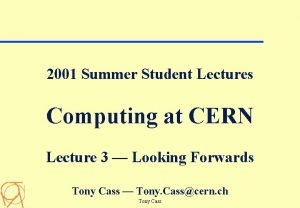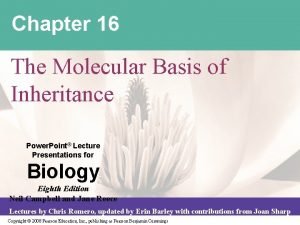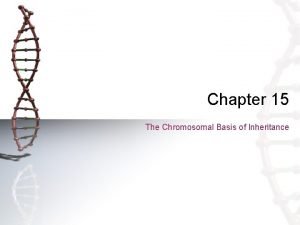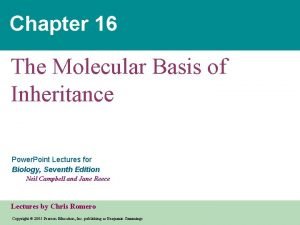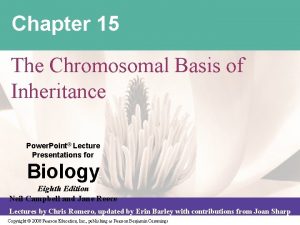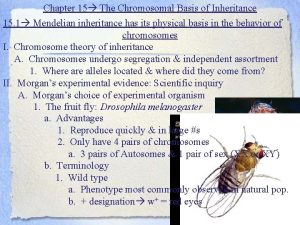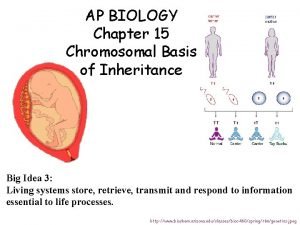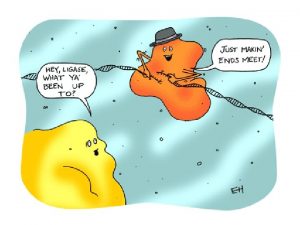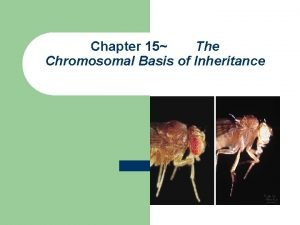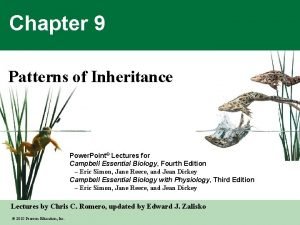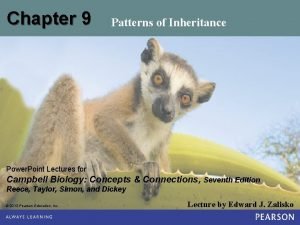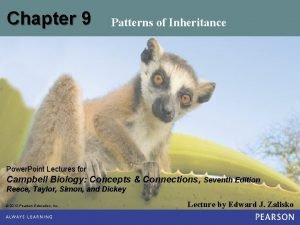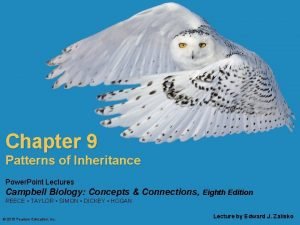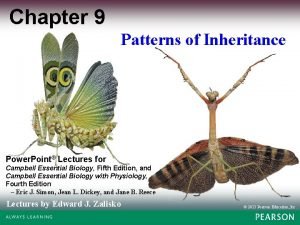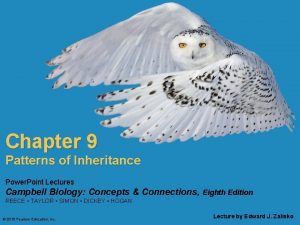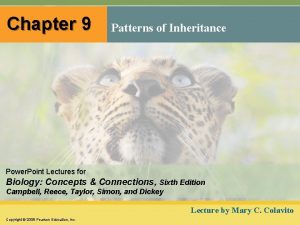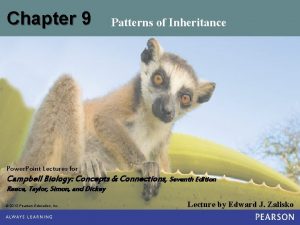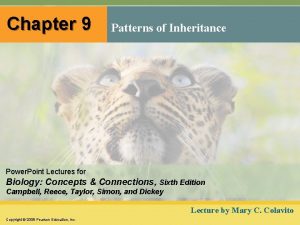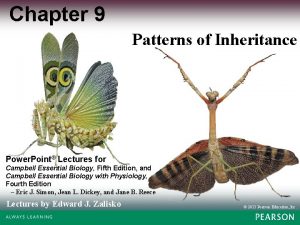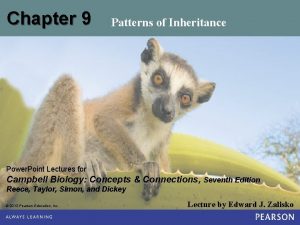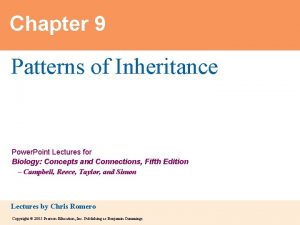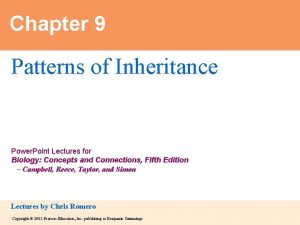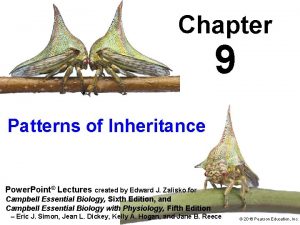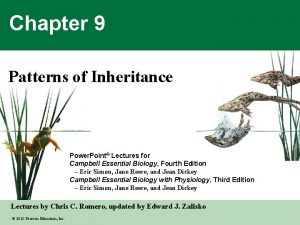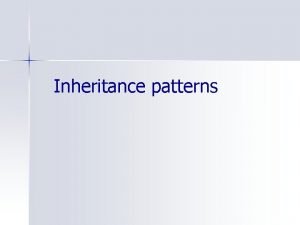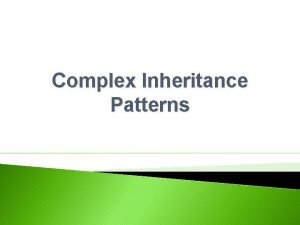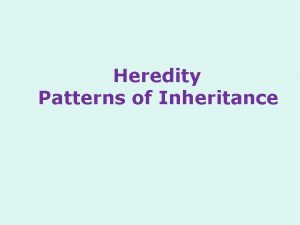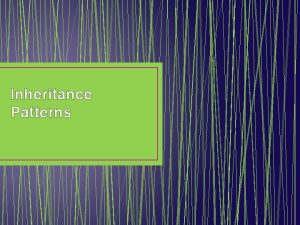Chapter 9 Patterns of Inheritance Power Point Lectures









































































- Slides: 73

Chapter 9 Patterns of Inheritance Power. Point Lectures Campbell Biology: Concepts & Connections, Eighth Edition REECE • TAYLOR • SIMON • DICKEY • HOGAN © 2015 Pearson Education, Inc. Lecture by Edward J. Zalisko

Figure 9. 0 -2 © 2015 Pearson Education, Inc. Chapter 9: Big Ideas Mendel’s Laws Variations on Mendel’s Laws The Chromosomal Basis of Inheritance Sex Chromosomes and Sex-Linked Genes

MENDEL’S LAWS 9. 1 -9. 10 © 2015 Pearson Education, Inc.

9. 1 The study of genetics has ancient roots • The Greek physician Hippocrates explained inheritance by proposing that particles called “pangenes” travel from each part of an organism’s body to the eggs or sperm and characteristics acquired during the parents’ lifetime could be transferred to the offspring. • In the 19 th century, the idea that hereditary materials mix in forming offspring, called the blending hypothesis, was suggested. © 2015 Pearson Education, Inc.

9. 2 The science of genetics began in an abbey garden • Heredity is the transmission of traits from one generation to the next. • Genetics is the scientific study of heredity. • Gregor Mendel • began the field of genetics in the 1860 s, • deduced the principles of genetics by breeding garden peas, and • relied upon a background of mathematics, physics, and chemistry. © 2015 Pearson Education, Inc.

9. 2 The science of genetics began in an abbey garden • In 1866, Mendel • correctly argued that parents pass on to their offspring discrete “heritable factors” and • stressed that the heritable factors (today called genes) retain their individuality generation after generation. • A heritable feature that varies among individuals, such as flower color, is called a character. • Each variant for a character, such as purple or white flowers, is a trait. © 2015 Pearson Education, Inc.

• When Mendel wanted to cross-fertilize plants, he • dusted its carpel with pollen from another plant to cross-fertilize the stamenless flower. • After pollination, the carpel developed into a pod, containing seeds (peas) that he later planted. © 2015 Pearson Education, Inc.

9. 2 The science of genetics began in an abbey garden • True-breeding varieties result when self-fertilization produces offspring all identical to the parent. • The offspring of two different varieties are hybrids. • The cross-fertilization is a hybridization, or genetic cross. • True-breeding parental plants are the P generation. • Hybrid offspring are the F 1 generation. • A cross of F 1 plants produces an F 2 generation. © 2015 Pearson Education, Inc.

Figure 9. 2 d-0 Character Traits Recessive Dominant Flower color Purple White Axial Terminal Yellow Green Round Wrinkled Inflated Constricted Green Yellow Tall Dwarf Flower position Seed color Seed shape Pod color Stem length © 2015 Pearson Education, Inc.

9. 3 Mendel’s law of segregation describes the inheritance of a single character • A cross between two individuals differing in a single character is a monohybrid cross. • Mendel performed a monohybrid cross between a plant with purple flowers and a plant with white flowers. • The F 1 generation produced all plants with purple flowers. • A cross of F 1 plants with each other produced an F 2 generation with ¾ purple and ¼ white flowers. © 2015 Pearson Education, Inc.

Figure 9. 3 a-3 The Experiment P generation (true-breeding parents) Purple flowers F 1 generation White flowers All plants have purple flowers Fertilization among F 1 plants (F 1 × F 1) F 2 generation 3 4 1 of plants 4 have purple flowers have white flowers © 2015 Pearson Education, Inc.

9. 3 Mendel’s law of segregation describes the inheritance of a single character • The all-purple F 1 generation did not produce light purple flowers, as predicted by the blending hypothesis. • Mendel needed to explain • why white color seemed to disappear in the F 1 generation and • why white color reappeared in one-quarter of the F 2 offspring. © 2015 Pearson Education, Inc.

9. 3 Mendel’s law of segregation describes the inheritance of a single character • Mendel developed four hypotheses, described below using modern terminology. 1. Alleles are alternative versions of genes that account for variations in inherited characters. 2. For each character, an organism inherits two alleles, one from each parent. The alleles can be the same or different. • A homozygous genotype has identical alleles. • A heterozygous genotype has two different alleles. © 2015 Pearson Education, Inc.

9. 3 Mendel’s law of segregation describes the inheritance of a single character 3. If the alleles of an inherited pair differ, then one determines the organism’s appearance and is called the dominant allele. The other has no noticeable effect on the organism’s appearance and is called the recessive allele. • The phenotype is the appearance or expression of a trait. • The genotype is the genetic makeup of a trait. • The same phenotype may be determined by more than one genotype. © 2015 Pearson Education, Inc.

9. 3 Mendel’s law of segregation describes the inheritance of a single character 4. A sperm or egg carries only one allele for each inherited character because allele pairs separate (segregate) from each other during the production of gametes. This statement is called the law of segregation. • The fusion of gametes at fertilization creates allele pairs once again. © 2015 Pearson Education, Inc.

9. 3 Mendel’s law of segregation describes the inheritance of a single character • Mendel’s hypotheses also explain the 3: 1 ratio in the F 2 generation. • The F 1 hybrids all have a Pp genotype. • A Punnett square shows the four possible combinations of alleles that could occur when these gametes combine.

Figure 9. 3 b-0 -3 The Explanation P generation Genetic makeup (alleles) Purple flowers White flowers PP pp Gametes All P All p F 1 generation (hybrids) All Pp Alleles segregate Gametes 1 2 P Fertilization F 2 generation Results: p Sperm from F 1 plant P Phenotypic ratio 3 purple : 1 white Genotypic ratio 1 PP : 2 Pp : 1 pp Eggs from F 1 plant P PP Pp pp Results © 2015 Pearson Education, Inc. p

9. 4 Homologous chromosomes bear the alleles for each character • A locus (plural, loci) is the specific location of a gene along a chromosome. • For a pair of homologous chromosomes (homologs), alleles of a gene reside at the same locus. • Homozygous individuals have the same allele on both homologs. • Heterozygous individuals have a different allele on each homolog. © 2015 Pearson Education, Inc.

Figure 9. 4 Gene loci P a B P a b Dominant allele Homologous chromosomes Genotype: © 2015 Pearson Education, Inc. PP Homozygous for the dominant allele aa Homozygous for the recessive allele Recessive allele Bb Heterozygous, with one dominant and one recessive allele

© 2015 Pearson Education, Inc.

9. 5 The law of independent assortment is revealed by tracking two characters at once • A dihybrid cross is a mating of parental varieties that differ in two characters. • Mendel performed the following dihybrid cross with the following results: • P generation: round yellow seeds wrinkled green seeds • F 1 generation: all plants with round yellow seeds

© 2015 Pearson Education, Inc.

9. 5 The law of independent assortment is revealed by tracking two characters at once • Mendel needed to explain why the F 2 offspring • had new nonparental combinations of traits and • had a 9: 3: 3: 1 phenotypic ratio. • Mendel • suggested that the inheritance of one character has no effect on the inheritance of another, • he called this the law of independent assortment • and he suggested that the dihybrid cross is the equivalent to two monohybrid crosses. © 2015 Pearson Education, Inc.

9. 6 Geneticists can use the testcross to determine unknown genotypes • A testcross is the mating between an individual of unknown genotype and a homozygous recessive individual. • Can show whether the unknown genotype includes a recessive allele.

9. 7 Mendel’s laws reflect the rules of probability • The probability of a specific event is the number of ways that event can occur out of the total possible outcomes. • Determining the probability of two independent events uses the rule of multiplication, in which the probability is the product of the probabilities for each event. • The probability that an event can occur in two or more alternative ways is the sum of the separate probabilities, called the rule of addition. © 2015 Pearson Education, Inc.

Figure 9. 7 F 1 genotypes Bb male Bb female Formation of eggs Formation of sperm What is the probability that an F 2 will have a bb genotype? What is the probability that an F 2 will be heterozygous? F 2 genotypes B Sperm B B b b Eggs b © 2015 Pearson Education, Inc. b

9. 8 VISUALIZING THE CONCEPT: Genetic traits in humans can be tracked through family pedigrees • A pedigree • shows the inheritance of a trait in a family through multiple generations, • demonstrates dominant or recessive inheritance, and • can also be used to deduce genotypes of family members. © 2015 Pearson Education, Inc.

Figure 9. 8 -2 KEY Female Mating Al Frank Beth Gary Charles Debbie 2 ND GENERATION Henry Straight hairline Isabel Juliana Widow’s peak 3 RD GENERATION Kristin © 2015 Pearson Education, Inc. H: widow’s peak allele h: straight allele 1 ST GENERATION Children Evelyn Widow’s peak hairline trait Straight hairline trait Lori

Figure 9. 8 -3 KEY Female Male Widow’s peak hairline trait Straight hairline trait H: widow’s peak allele h: straight allele 1 ST GENERATION Al Beth Charles Debbie Hh Hh hh Hh 2 ND GENERATION Evelyn Frank Gary Henry hh hh Hh Straight hairline Isabel Juliana Hh hh 3 RD GENERATION Kristin hh © 2015 Pearson Education, Inc. A parent with a widow’s peak who has a child with a straight hairline must be Hh. Kristin has a straight Lori hairline but her parents do not, so straight hairline must be homozygous recessive (hh). Widow’s peak

Figure 9. 8 -4 KEY Female Male Widow’s peak hairline trait Straight hairline trait H: widow’s peak allele h: straight allele 1 ST GENERATION Al Beth Charles Debbie Hh Hh hh Hh 2 ND GENERATION Evelyn Frank Gary Henry Isabel Juliana HH hh hh Hh Hh hh or Hh Straight hairline Widow’s peak 3 RD GENERATION Not all genotypes can be determined. Lori could be Kristin HH or Hh and there is no Lori way to know (unless she hh has some children and the HH or pedigree is extended). Hh © 2015 Pearson Education, Inc.

9. 9 Many inherited traits in humans are controlled by a single gene • Because a trait is dominant does not mean that it is “normal” or more common than a recessive trait. • Wild-type traits are • those most often seen in nature and • not necessarily specified by dominant alleles.

9. 9 CONNECTION: Many inherited traits in humans are controlled by a single gene • These genetic disorders are known to be inherited as dominant or recessive traits controlled by a single gene.

9. 9 Many inherited traits in humans are controlled by a single gene • Most people who have recessive disorders are born to normal parents who are both heterozygotes, carriers of the recessive allele for the disorder, but are phenotypically normal.

9. 10 CONNECTION: New technologies can provide insight into one’s genetic legacy • Modern technologies offer ways to obtain genetic information • before conception, • during pregnancy, and • after birth. • Genetic testing can identify prospective parents who are heterozygous carriers for certain diseases. • Newborn screening can detect diseases that can be prevented by special care and precautions. © 2015 Pearson Education, Inc.

9. 10 CONNECTION: New technologies can provide insight into one’s genetic legacy • Several technologies can be used for detecting genetic conditions in a fetus. • Amniocentesis extracts samples of amniotic fluid containing fetal cells and permits karyotyping to detect chromosomal abnormalities • Chorionic villus sampling removes a sample of chorionic villus tissue from the placenta and permits similar karyotyping and biochemical tests. • Blood tests on the mother can help identify fetuses at risk for certain birth defects. • Ultrasound imaging enables a physician to examine a fetus directly for anatomical deformities. Newborn screening can detect diseases that can be prevented by special care and precautions.

VARIATIONS ON MENDEL’S LAWS 9. 11 -9. 15 © 2015 Pearson Education, Inc.

9. 11 Incomplete dominance results in intermediate phenotypes • Mendel’s pea crosses always looked like one of the two parental varieties, a situation called complete dominance. • For some characters, the appearance of F 1 hybrids falls between the phenotypes of the two parental varieties. This is called incomplete dominance.

9. 11 Incomplete dominance results in intermediate phenotypes • One example of incomplete dominance in humans is hypercholesterolemia, in which • dangerously high levels of cholesterol occur in the blood and heterozygotes have intermediately high cholesterol levels.

9. 12 Many genes have more than two alleles in the population • Although each individual carries, at most, two different alleles for a particular gene, in cases of multiple alleles, more than two possible alleles exist in a population. • For example, human ABO blood group phenotypes involve three alleles for a single gene. • The four human blood groups, A, B, AB, and O, result from combinations of these three alleles. • The A and B alleles are both expressed in heterozygous individuals, making both alleles codominant.

Figure 9. 12 -0 Blood Carbohydrates Present Group Genotypes on Red Blood Cells (Phenotype) A IAIA or IAi Carbohydrate A Carbohydrate B B IBIB or IBi AB IAIB O ii Antibodies Present in Blood Reaction When Blood from Groups Below Is Mixed with Antibodies from Groups at Left O AB A B Anti-A Carbohydrate A and Carbohydrate B Neither None Anti-A Anti-B No reaction © 2015 Pearson Education, Inc. Clumping reaction

9. 13 A single gene may affect many phenotypic characters • Pleiotropy occurs when one gene influences multiple characters. • Sickle-cell disease is a human example of pleiotropy. • This disease affects the type of hemoglobin produced and the shape of red blood cells. • Sickle-cell and nonsickle alleles are codominant.

Figure 9. 13 b An individual homozygous for the sickle-cell allele Produces sickle-cell (abnormal) hemoglobin The abnormal hemoglobin crystallizes, causing red blood cells to become sickle-shaped Damage to organs Kidney failure Heart failure Spleen damage Brain damage (impaired mental function, paralysis) © 2015 Pearson Education, Inc. Other effects Pain and fever Joint problems Physical weakness Anemia Pneumonia and other infections

9. 14 A single character may be influenced by many genes • Many characters result from polygenic inheritance, in which a single phenotypic character results from the additive effects of two or more genes. • Example: Human skin color

9. 14 A single character may be influenced by many genes

9. 15 The environment affects many characters • Many characters result from a combination of heredity and the environment. • skin color is affected by exposure to sunlight and • heart disease and cancer are influenced by genes and the environment. • Identical twins show that a person’s traits are the results of genetics and the environment.

THE CHROMOSOMAL BASIS OF INHERITANCE 9. 16 -9. 19 © 2015 Pearson Education, Inc.

9. 16 Chromosome behavior accounts for Mendel’s laws • The chromosome theory of inheritance states that • genes occupy specific loci (positions) on chromosomes and • chromosomes undergo segregation and independent assortment during meiosis. © 2015 Pearson Education, Inc.

9. 16 Chromosome behavior accounts for Mendel’s laws • Mendel’s laws correlate with chromosome separation in meiosis. • The law of segregation • states that pairs of alleles separate from each other during gamete formation via meiosis and • depends on separation of homologous chromosomes in anaphase I. • The law of independent assortment • states that each pair of alleles sorts independently of other pairs of alleles during gamete formation and • depends on alternative orientations of chromosomes in metaphase I. © 2015 Pearson Education, Inc.

Law of Segregation Law of Independent Assortment

9. 17 Genes on the same chromosome tend to be inherited together • Bateson and Punnett studied plants that did not show a 9: 3: 3: 1 ratio in the F 2 generation. • What they found was linked genes, which • are located close together on the same chromosome and • tend to be inherited together. © 2015 Pearson Education, Inc.

9. 18 Crossing over produces new combinations of alleles • Crossing over between homologous chromosomes produces new combinations of alleles in gametes. • Linked genes can be separated by crossing over, forming recombinant gametes. • The percentage of recombinant offspring is the recombination frequency.

9. 18 Crossing over produces new combinations of alleles © 2015 Pearson Education, Inc.

9. 19 Geneticists use crossover data to map genes • The greater the distance between two genes on a chromosome, the more points there are between them where crossing over can occur. • Recombination frequencies can thus be used to map the relative position of genes on chromosomes. • A diagram of relative gene locations is called a linkage map.

SEX CHROMOSOMES AND SEX-LINKED GENES 9. 20 -9. 23 © 2015 Pearson Education, Inc.

9. 20 Chromosomes determine sex in many species • Many animals have a pair of sex chromosomes, designated X and Y, that determine an individual’s sex. • Among humans and other mammals, • XY individuals are males • XX individuals are females. • In addition, human males and females both have 44 autosomes (nonsex chromosomes). © 2015 Pearson Education, Inc.

9. 20 Chromosomes determine sex in many species

9. 21 Sex-linked genes exhibit a unique pattern of inheritance • Sex-linked genes are located on either of the sex chromosomes. • The X chromosome carries many genes unrelated to sex. • The inheritance of white eye color in the fruit fly illustrates an X-linked recessive trait.

9. 21 Sex-linked genes exhibit a unique pattern of inheritance

9. 22 Human sex-linked disorders affect mostly males • Most sex-linked human disorders are • due to recessive alleles and • seen mostly in males. • A male receiving a single X-linked recessive allele from his mother will have the disorder. • A female must receive the allele from both parents to be affected. © 2015 Pearson Education, Inc.

9. 22 Human sex-linked disorders affect mostly males • Recessive and sex-linked human disorders include • hemophilia, characterized by excessive bleeding because hemophiliacs lack one or more of the proteins required for blood clotting, • red-green colorblindness, a malfunction of lightsensitive cells in the eyes, and • Duchenne muscular dystrophy, a condition characterized by a progressive weakening of the muscles and loss of coordination. © 2015 Pearson Education, Inc.

9. 22 Human sex-linked disorders affect mostly males


You should now be able to 1. Describe theory of pangenes and the blending hypothesis. Explain why both ideas are now rejected. 2. Define and distinguish between true-breeding organisms, hybrids, the P generation, the F 1 generation, and the F 2 generation. © 2015 Pearson Education, Inc.

You should now be able to 3. Define and distinguish between the following pairs of terms: • homozygous and heterozygous; • dominant allele and recessive allele; • genotype and phenotype. Also, define a monohybrid cross and a Punnett square. © 2015 Pearson Education, Inc.

You should now be able to 4. Explain how Mendel’s law of segregation describes the inheritance of a single character. 5. Describe the genetic relationships between homologous chromosomes. 6. Explain how Mendel’s law of independent assortment applies to a dihybrid cross. 7. Explain how and when the rule of multiplication and the rule of addition can be used to determine the probability of an event. © 2015 Pearson Education, Inc.

You should now be able to 8. Explain how family pedigrees can help determine the inheritance of many human traits. 9. Explain how recessive and dominant disorders are inherited. Provide examples of each. 10. Compare the health risks, advantages, and disadvantages of the following forms of fetal testing: • amniocentesis, • chorionic villus sampling, and • ultrasound imaging. © 2015 Pearson Education, Inc.

You should now be able to 11. Describe the inheritance patterns of incomplete dominance, multiple alleles, codominance, pleiotropy, and polygenic inheritance. 12. Explain how the sickle-cell allele can be adaptive. 13. Explain why human skin coloration is not sufficiently explained by polygenic inheritance. 14. Define the chromosome theory of inheritance. Explain the chromosomal basis of the laws of segregation and independent assortment. © 2015 Pearson Education, Inc.

You should now be able to 15. Explain how linked genes are inherited differently from nonlinked genes. 16. Describe T. H. Morgan’s studies of crossing over in fruit flies. Explain how Sturtevant created linkage maps. 17. Explain how sex is genetically determined in humans and the significance of the SRY gene. 18. Describe patterns of sex-linked inheritance and examples of sex-linked disorders. 19. Explain how the Y chromosome can be used to trace human ancestry. © 2015 Pearson Education, Inc.

Figure 9. UN 01 Homologous chromosomes Alleles, residing at the same locus Fertilization Meiosis Paired alleles, different forms of a gene © 2015 Pearson Education, Inc. Gamete from the other parent Haploid gametes (allele pairs separated) Diploid zygote (containing paired alleles)

Figure 9. UN 02 Incomplete dominance Red RR © 2015 Pearson Education, Inc. White rr Pink Rr

Figure 9. UN 03 Single gene © 2015 Pearson Education, Inc. Pleiotropy Multiple characters

Figure 9. UN 04 Multiple genes © 2015 Pearson Education, Inc. Polygenic inheritance Single characters (such as skin color)

Figure 9. UN 05 Genes alternative versions called located on (a) chromosomes at specific locations called (b) if both are the same, the genotype is called if different, the genotype is called (c) heterozygous the expressed allele is called (d) the unexpressed allele is called (e) inheritance when the phenotype is in between is called (f) © 2015 Pearson Education, Inc.
 Complex patterns of inheritance
Complex patterns of inheritance Chapter 9 patterns of inheritance
Chapter 9 patterns of inheritance Chapter 11 section 1 basic patterns of human inheritance
Chapter 11 section 1 basic patterns of human inheritance Chapter 11 section 1 basic patterns of human inheritance
Chapter 11 section 1 basic patterns of human inheritance Chapter 9 patterns of inheritance
Chapter 9 patterns of inheritance Power system lectures
Power system lectures Complete dominance pattern of inheritance
Complete dominance pattern of inheritance Complex patterns of inheritance
Complex patterns of inheritance Mendelian pattern of inheritance
Mendelian pattern of inheritance Power triangle diagram
Power triangle diagram Informsu
Informsu Point point power
Point point power Obj dating
Obj dating Closed patterns and max-patterns
Closed patterns and max-patterns Rick trebino lectures
Rick trebino lectures Neonatology lectures
Neonatology lectures Data mining lectures
Data mining lectures Medicinal chemistry lectures
Medicinal chemistry lectures Uva powerpoint template
Uva powerpoint template Cs614 short lectures
Cs614 short lectures Software project management lectures
Software project management lectures Cell and molecular biology lectures
Cell and molecular biology lectures Radio astronomy lectures
Radio astronomy lectures Dr sohail lectures
Dr sohail lectures Utilities and energy lectures
Utilities and energy lectures Introduction to web engineering
Introduction to web engineering How to get the most out of lectures
How to get the most out of lectures Frcr physics lectures
Frcr physics lectures Frcr physics lectures
Frcr physics lectures Introduction to recursion
Introduction to recursion Rbc formation stages
Rbc formation stages What is aerodynamics
What is aerodynamics Theory of translation lectures
Theory of translation lectures What is text linguistics
What is text linguistics Translation 1
Translation 1 Digital logic design lectures
Digital logic design lectures Jim kurose gaia
Jim kurose gaia Hegel classical art
Hegel classical art Nuclear medicine lectures
Nuclear medicine lectures Cs106b lectures
Cs106b lectures Cdeep lectures
Cdeep lectures Oral communication 3 lectures text
Oral communication 3 lectures text C programming lectures
C programming lectures Haematology lectures
Haematology lectures Bureau of lectures
Bureau of lectures Slagle lecture
Slagle lecture Theory of translation lectures
Theory of translation lectures Reinforcement learning lectures
Reinforcement learning lectures 13 lectures
13 lectures Reinforcement learning lectures
Reinforcement learning lectures Bba lectures
Bba lectures Medical emergency student lectures
Medical emergency student lectures Medical student hematology lectures
Medical student hematology lectures Rcog eportfolio
Rcog eportfolio Bhadeshia lectures
Bhadeshia lectures Yelena bogdan md
Yelena bogdan md Comsats virtual campus lectures
Comsats virtual campus lectures Hugh blair lectures on rhetoric
Hugh blair lectures on rhetoric Cern summer student lectures
Cern summer student lectures Pathology lectures for medical students
Pathology lectures for medical students Dr asim lectures
Dr asim lectures Pab ankle fracture
Pab ankle fracture Anatomy lectures powerpoint
Anatomy lectures powerpoint Cern summer school lectures
Cern summer school lectures Chapter 16 the molecular basis of inheritance
Chapter 16 the molecular basis of inheritance Chapter 15: the chromosomal basis of inheritance
Chapter 15: the chromosomal basis of inheritance Chapter 11 complex inheritance and human heredity test
Chapter 11 complex inheritance and human heredity test Chapter 16: the molecular basis of inheritance
Chapter 16: the molecular basis of inheritance Chapter 15: the chromosomal basis of inheritance
Chapter 15: the chromosomal basis of inheritance The chromosomal basis of inheritance chapter 15
The chromosomal basis of inheritance chapter 15 Chapter 15 the chromosomal basis of inheritance
Chapter 15 the chromosomal basis of inheritance Primase
Primase Chapter 15 the chromosomal basis of inheritance
Chapter 15 the chromosomal basis of inheritance Jeff anderson patterns of power
Jeff anderson patterns of power
